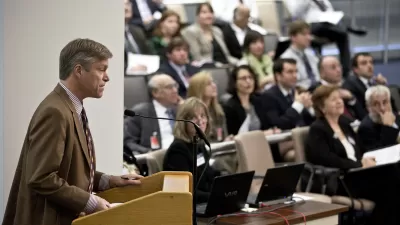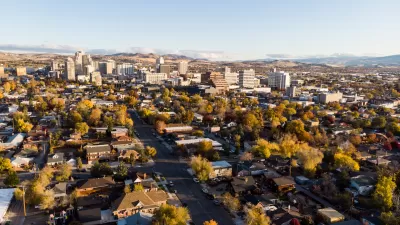In this era of increased inequality, socially-blind urban planning is morally questionable. Specifically, on the issue of homelessness in America, there are three problems to which planners need to pay particular attention.

The contrast between prosperity and poverty is most dramatic in the harshness of inclement weather. In San Diego this past weekend, while the storms resulting from El Nino lashed at the city, I drove through East Village, a neighborhood that contains one of the largest concentrations of homeless in the region. It is also the epicenter of Downtown’s new construction boom.
Amidst the broken tree branches and debris, scattered and soaked in the storm water were large black trash bags that homeless people had used to protect themselves. I saw helplessness in the eyes of an elderly couple as the rain whipped at them from every direction, drenching their belongings. An orderly line of about a half dozen people waited on the sidewalk for their turn to use the portable bathrooms, seemingly numb to the pouring rain. A series of blue tents clustered under the freeway bridge, sharing a tarp, and a young woman was braving the gusty winds to stand at that intersection, her hands clenching a soaked cardboard sign that simply read, “Homeless, Hungry.”
In the background, I saw construction cranes idling in the sky above them, poised to continue building a teal-colored luxury condominium tower with yellow and white accents.
America’s Finest City has an ugly problem.
The homeless population in San Diego is among the four largest in the nation and getting worse, with over 8,700 people living without shelter. And while this kind of weather is rare in San Diego, it is not new, yet even after anticipating the storm for months and knowing the severity of our homelessness problem, there was marginal galvanization of resources by local government. Simultaneously, the city was able to commit hundreds of millions of dollars in public funds for supporting downtown development with an expanded convention center and a Chargers stadium that the NFL does not want, all of which will likely be built in the very neighborhood these people call home.
In this era of increased inequality, socially-blind urban planning is morally questionable. Specifically, on the issue of homelessness in America, there are three problems that planners need to pay attention to:
Social impacts of planning are relegated to the margins. Planners often consider development projects from the sterile perspective of social value-free growth. Social issues such as homelessness appear as ancillary considerations, footnoted, or completely omitted in normal project planning and permitting processes. Social issues such as homelessness appear as ancillary considerations, footnoted, or completely omitted in normal project planning and permitting processes. I have served almost three years as a board member of San Diego’s downtown planning and permitting agency, yet not once has the issue of displacement been addressed by the agency when approving an unsubsidized housing project. Not once has a “vacant lot” that was at the time housing homeless people been treated as anything but developable dirt. Most developers proposing luxury housing projects in downtown get away providing no inclusionary housing and mandatory minimum fees. And there is a concerted effort in the street-front design of these towers to ensure that the homeless cannot sit, sleep or stay in the area.
FULL STORY: Socially-Blind Urban Planning

Depopulation Patterns Get Weird
A recent ranking of “declining” cities heavily features some of the most expensive cities in the country — including New York City and a half-dozen in the San Francisco Bay Area.

California Exodus: Population Drops Below 39 Million
Never mind the 40 million that demographers predicted the Golden State would reach by 2018. The state's population dipped below 39 million to 38.965 million last July, according to Census data released in March, the lowest since 2015.

Chicago to Turn High-Rise Offices into Housing
Four commercial buildings in the Chicago Loop have been approved for redevelopment into housing in a bid to revitalize the city’s downtown post-pandemic.

How California Transit Agencies are Addressing Rider Harassment
Safety and harassment are commonly cited reasons passengers, particularly women and girls, avoid public transit.

Significant Investments Needed to Protect LA County Residents From Climate Hazards
A new study estimates that LA County must invest billions of dollars before 2040 to protect residents from extreme heat, increasing precipitation, worsening wildfires, rising sea levels, and climate-induced public health threats.

Federal Rule Raises Cost for Oil and Gas Extraction on Public Lands
An update to federal regulations raises minimum bonding to limit orphaned wells and ensure cleanup costs are covered — but it still may not be enough to mitigate the damages caused by oil and gas drilling.
City of Costa Mesa
Licking County
Barrett Planning Group LLC
HUD's Office of Policy Development and Research
Mpact Transit + Community
HUD's Office of Policy Development and Research
City of Universal City TX
ULI Northwest Arkansas
City of Laramie, Wyoming
Urban Design for Planners 1: Software Tools
This six-course series explores essential urban design concepts using open source software and equips planners with the tools they need to participate fully in the urban design process.
Planning for Universal Design
Learn the tools for implementing Universal Design in planning regulations.





















